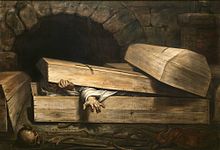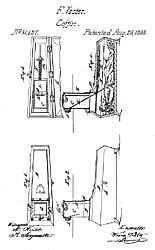
A funeral is a ceremony connected with the final disposition of a corpse, such as a burial or cremation, with the attendant observances. Funerary customs comprise the complex of beliefs and practices used by a culture to remember and respect the dead, from interment, to various monuments, prayers, and rituals undertaken in their honour. Customs vary between cultures and religious groups. Funerals have both normative and legal components. Common secular motivations for funerals include mourning the deceased, celebrating their life, and offering support and sympathy to the bereaved; additionally, funerals may have religious aspects that are intended to help the soul of the deceased reach the afterlife, resurrection or reincarnation.

Burial, also known as interment or inhumation, is a method of final disposition whereby a dead body is placed into the ground, sometimes with objects. This is usually accomplished by excavating a pit or trench, placing the deceased and objects in it, and covering it over. A funeral is a ceremony that accompanies the final disposition. Evidence suggests that some archaic and early modern humans buried their dead. Burial is often seen as indicating respect for the dead. It has been used to prevent the odor of decay, to give family members closure and prevent them from witnessing the decomposition of their loved ones, and in many cultures it has been seen as a necessary step for the deceased to enter the afterlife or to give back to the cycle of life.
Adipocere, also known as corpse wax, grave wax or mortuary wax, is a wax-like organic substance formed by the anaerobic bacterial hydrolysis of fat in tissue, such as body fat in corpses. In its formation, putrefaction is replaced by a permanent firm cast of fatty tissues, internal organs, and the face.
The health risks of dead bodies are dangers related to the improper preparation and disposal of cadavers. While normal circumstances allow cadavers to be quickly embalmed, cremated, or buried; natural and man-made disasters can quickly overwhelm and/or interrupt the established protocols for dealing with the dead. Under such circumstances, the decomposition and putrefaction of cadavers goes unchecked, and raises a series of health, logistical, and psychological issues. After disasters with extensive loss of life due to trauma rather than disease—earthquakes, storms, human conflict, etc.—many resources are often expended on burying the dead quickly, and applying disinfectant to bodies for the specific purpose of preventing disease. Specialists say that spraying is a waste of disinfectant and manpower, that "resources that should be going into establishment of water supply, sanitation, shelter, warmth and hygienic food for the survivors are being applied to digging mass graves", and that "Time and time again, eminent and authoritative experts have pointed out that dead bodies do not constitute a health hazard".

A body bag, also known as a cadaver pouch or human remains pouch (HRP), is a non-porous bag designed to contain a human body, used for the storage and transportation of shrouded corpses.

Premature burial, also known as live burial, burial alive, or vivisepulture, means to be buried while still alive.
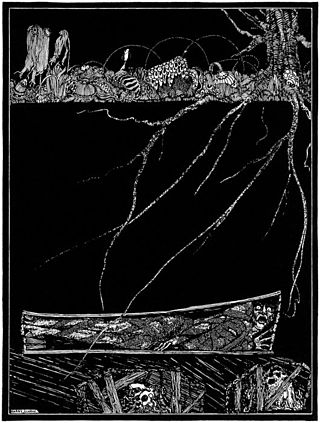
"The Premature Burial" is a horror short story by American writer Edgar Allan Poe, published in 1844 in The Philadelphia Dollar Newspaper. Its main character expresses concern about being buried alive. This fear was common in this period and Poe was taking advantage of the public interest. The story has been adapted to a film.

A Christian burial is the burial of a deceased person with specifically Christian rites; typically, in consecrated ground. Until recent times Christians generally objected to cremation because it interfered with the concept of the resurrection of a corpse, and practiced inhumation almost exclusively. Today this opposition has all but vanished among Protestants and Catholics alike, and this is rapidly becoming more common, although Eastern Orthodox Churches still mostly forbid cremation.

Taphophobia is an abnormal (psychopathological) phobia of being buried alive as a result of being incorrectly pronounced dead.

Corpse roads provided a practical means for transporting corpses, often from remote communities, to cemeteries that had burial rights, such as parish churches and chapels of ease. In Britain, such routes can also be known by a number of other names, e.g.: bier road, burial road, coffin line, coffin road, corpse way, funeral road, lych way, lyke way, or procession way. etc. Such "church-ways" have developed a great deal of associated folklore regarding ghosts, spirits, wraiths, etc.

Hannah Beswick, of Birchin Bower, Hollinwood, Oldham, Greater Manchester, was a wealthy woman who had a pathological fear of premature burial. Following her death in 1758, her body was embalmed and kept above ground, to be periodically checked for signs of life.

The Premature Burial, also known as Premature Burial, is a 1962 American horror film directed by Roger Corman and starring Ray Milland, Hazel Court, Alan Napier, Heather Angel and Richard Ney. The screenplay by Charles Beaumont and Ray Russell is based upon the 1844 short story of the same name by Edgar Allan Poe. It was the third in the series of eight Poe-themed pictures, known informally as the "Poe Cycle", directed by Corman for American International Pictures.

During the Pre-Hispanic period the early Filipinos believed in a concept of life after death. This belief, which stemmed from indigenous ancestral veneration and was strengthened by strong family and community relations within tribes, prompted the Filipinos to create burial customs to honor the dead through prayers and rituals. Due to different cultures from various regions of the Philippines, many different burial practices have emerged. For example, the Manobos buried their dead in trees, the Ifugaos seated the corpse on a chari before it was brought to a cave and buried elsewhere. The most common forms of traditional burials are supine pits, earthenware jars, and log coffins, and have been a topic of interest among Philippine archaeologists since the early 20th century.

The Bestattungsmuseum Wien is a museum in Vienna, Austria. With around 1,000 exhibits, the Vienna Funeral Museum gives a comprehensive overview of funeral customs, burial rites, funerary art and the special Viennese perspective on death and provides information on the historical and current funeral services in Vienna.
The vjesci is a vampire in Polish folklore. According to legend, a person was destined to be a vjesci from the time they were born, and could be discerned from a caul located on the newborn's head. In order to prevent the person from becoming a vjesci, the caul was removed, dried, ground and fed to the person on their seventh birthday. Typically, vjesci were said to be normal in appearance, although in some cases, it was said to have an excitable nature and a ruddy complexion. At the time of their death, a vjesci would refuse to take the sacrament. The body would cool closely, and the limbs would remain limber. The lips and cheeks would remain red, and spots of blood often appeared under the fingernails and on the face.
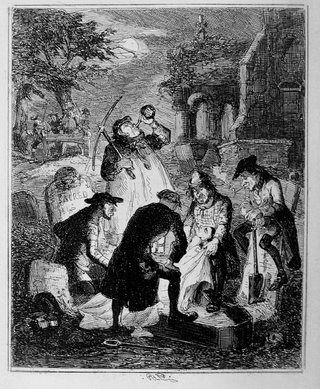
Resurrectionists were body snatchers who were commonly employed by anatomists in the United Kingdom during the 18th and 19th centuries to exhume the bodies of the recently dead. Between 1506 and 1752 only a very few cadavers were available each year for anatomical research. The supply was increased when, in an attempt to intensify the deterrent effect of the death penalty, Parliament passed the Murder Act 1752. By allowing judges to substitute the public display of executed criminals with dissection, the new law significantly increased the number of bodies anatomists could legally access. This proved insufficient to meet the needs of the hospitals and teaching centres that opened during the 18th century. Corpses and their component parts became a commodity, but although the practice of disinterment was hated by the general public, bodies were not legally anyone's property. The resurrectionists therefore operated in a legal grey area.
The London Association for the Prevention of Premature Burial was an association that was co-founded in 1896 by William Tebb and Walter Hadwen. In the 1800s, it was not common nor mandatory for a physician to examine a body after death and declare the person deceased. The absence of a final check by a competent person for signs of life led to fears of premature burial. The London Association for the Prevention of Premature Burial was created to bring attention to the perceived problem of this state of affairs. The association campaigned for improvements in death certification and for the building of "safety coffins" with warning devices that could be activated by a person mistakenly declared dead and buried.
Eleanor Markham was an American woman who became one of the most prominent cases of an averted premature burial in the late 19th century.
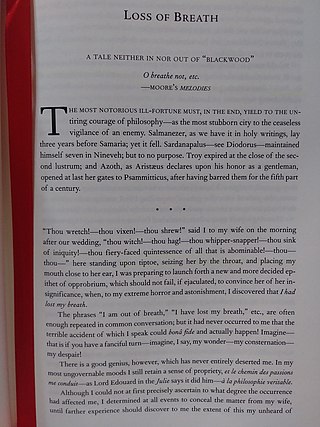
"Loss of Breath", also known as "Loss of Breath: A Tale Neither in Nor Out of 'Blackwood' ", is a short story written by American author Edgar Allan Poe under the pseudonym "Littleton Barry". A satirical tale, the story is narrated by Mr. Lackobreath who recounts his attempt to find and reclaim his lost breath, which he had literally misplaced. Throughout his journey, he is repeatedly dismembered and disfigured, falsely assumed to be dead, hanged, locked away, and prematurely interred. The absurd exaggerations may be explained by the fact that the tale was meant to satirize fiction published in the Edinburgh Blackwood Magazine, which was known for its sensational texts.
A burial artist is a person who intentionally endures premature burial by being voluntarily buried for extended periods as a form of human endurance contests, endurance art, escapology, or magic (illusion).

